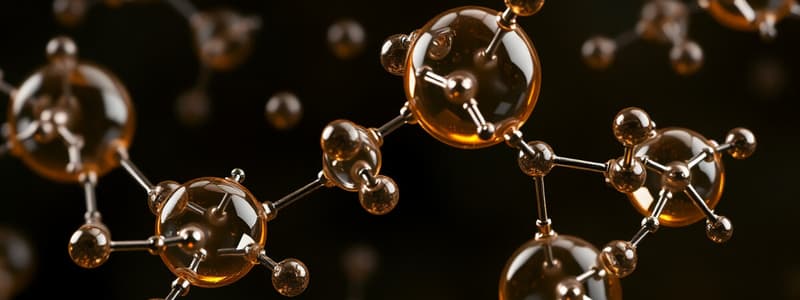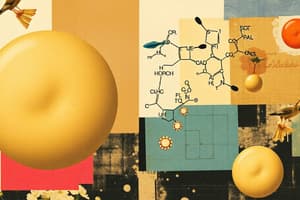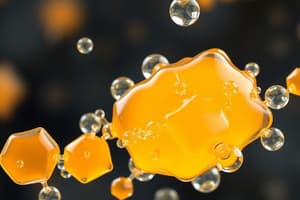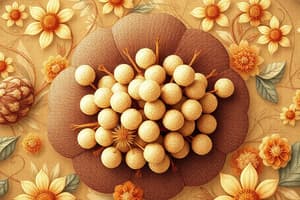Podcast
Questions and Answers
What are lipids primarily used for in living organisms?
What are lipids primarily used for in living organisms?
Long-term energy storage
Which of the following are categories of lipids? (Select all that apply)
Which of the following are categories of lipids? (Select all that apply)
- Carbohydrates
- Steroids (correct)
- Triglycerides (correct)
- Waxes (correct)
- Phospholipids (correct)
Lipids are hydrophilic and mix well with water.
Lipids are hydrophilic and mix well with water.
False (B)
Triglycerides are made up of ______ and fatty acids.
Triglycerides are made up of ______ and fatty acids.
What is the chemical process called that links glycerol with fatty acids to form triglycerides?
What is the chemical process called that links glycerol with fatty acids to form triglycerides?
Which part of the fatty acid molecule is hydrophilic?
Which part of the fatty acid molecule is hydrophilic?
Which fatty acid type contains only single bonds?
Which fatty acid type contains only single bonds?
In saturated fatty acids, the hydrocarbon chain is ______.
In saturated fatty acids, the hydrocarbon chain is ______.
What defines an unsaturated fatty acid?
What defines an unsaturated fatty acid?
Flashcards
Lipid's main function
Lipid's main function
Long-term energy storage in organisms
Lipid categories
Lipid categories
One category of lipids is steroids
Lipid water solubility
Lipid water solubility
Lipids are hydrophobic; they do NOT mix with water.
Triglyceride components
Triglyceride components
Signup and view all the flashcards
Triglyceride formation
Triglyceride formation
Signup and view all the flashcards
Hydrophilic part of fatty acid
Hydrophilic part of fatty acid
Signup and view all the flashcards
Saturated fatty acid structure
Saturated fatty acid structure
Signup and view all the flashcards
Unsaturated fatty acid
Unsaturated fatty acid
Signup and view all the flashcards
Saturated hydrocarbon chain shape
Saturated hydrocarbon chain shape
Signup and view all the flashcards
Study Notes
Lipids
- Biomolecules with primary function of long-term energy storage
- Primarily hydrophobic
- Made up of mostly carbon-hydrogen bonds (hydrocarbons)
Types of Lipids
- Triglycerides
- Phospholipids
- Steroids
- Waxes
Triglycerides
- Include fats and oils
- Fats are solid at room temperature and used by animals for long-term energy storage
- Oils are liquid at room temperature and used by plants for long-term energy storage
- Composed of glycerol and fatty acids
Glycerol
- Three-carbon chain
- Each carbon atom has a hydroxyl (-OH) group attached
Fatty Acids
- Three separate chains chemically bonded to glycerol
- Contain a carboxyl group at the polar end and a hydrocarbon chain at the nonpolar tail
- Amphipathic due to the hydrophilic carboxyl group and hydrophobic hydrocarbon tail
Saturated Fatty Acids
- Only single bonds
- Straight hydrocarbon tail
Unsaturated Fatty Acids
- Carbon-carbon double bonds in the chain
- Usually have a cis configuration at the double bond
- Cis configuration puts a kink in the hydrocarbon tail
- Trans configuration creates a straight hydrocarbon tail, similar to saturated fatty acids
Studying That Suits You
Use AI to generate personalized quizzes and flashcards to suit your learning preferences.




